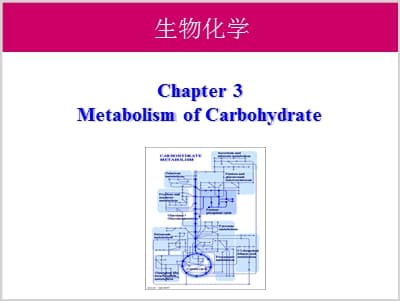生物化学.ppt

 1615251280解决。
1615251280解决。
1张
生物化学
Chapter 3 Metabolism of Carbohydrate
2张
糖分解代谢的调节
如代谢过程中加入碘乙酸,氟化物,结果如何?
3张
第四节 磷酸己糖支路 (HMP途径) Pentaose phosphate pathway p147
碘乙酸,氟化物等EMP相关酶抑制剂的加入,葡萄糖仍被利用. 同位素的标记葡萄糖C1,C6,标明放出的C1:C6比例不同.更多的是C1.Why?
HMP
4张
第四节 磷酸己糖支路 (HMP途径) p147
(Gp:) 己糖单磷酸途径 (Hexose Monophosphate Pathway)
(Gp:) 戊糖(磷酸)支路 (pentose phosphate shunt)
(Gp:) 磷酸己糖支路 (Hexose Monophosphate shunt)
(Gp:) 磷酸己糖旁路
(Gp:) 磷酸葡萄糖酸途径(phosphogluconate pathway)
Also known as:
It occurs in the cytosol (细胞溶质).
5张
标题: 4. 磷酸己糖支路(HMP)
正文: 1、可在有氧条件下进行; 2、整个代谢途径在细胞液中进行; 3、代谢主要目的不是获得能量,而是获得还原能力.
4.1 概 述
One fate of G6P is the pentose pathway.
6张
正文: The pathway begins with the glycolytic intermediate glucose 6-P(G-6-P). It reconnects with glycolysis because two of the end products of the pentose pathway are glyceraldehyde 3-P (G-3-P) and fructose 6-P(F-6-P); two intermediates further down in the glycolytic pathway. It is for this reason that the pentose pathway is often referred to as a shunt (支路).
The pentose pathway is a shunt.
glyceraldehyde 3-P (G-3-P)
fructose 6-P(F-6-P)
7张
It’s a shunt
HMP
8张
正文: The pathway yields reducing potential in the form of NADPH . The pathway yields ribose 5-phosphate (核糖-5-P). DNA RNA Various cofactors (CoA, FAD, SAM:S-腺苷甲硫氨酸, NAD+/NADP+).
What does the pentose phosphate pathway achieve?
9张
HMP提供大量还原能(NADPH)
NADPH is a phosphorylated form of NADH.
In general, with some exceptions, NADH is used to drive the phosphorylation of ADP to ATP. NADPH is used where reducing potential is required for synthetic reactions.
10张
脂肪酸
胆固醇
神经传递素
核苷
解毒
合成
谷胱甘肽
单(加)氧酶
NADPH参于的代谢
11张
Pythagoras毕达哥拉斯
Falafel沙拉三明治
fava bean ?蚕豆?
12张
标题: 4. 磷酸己糖支路(HMP)
正文: 4. 可产生戊糖、四碳糖等生物合成的原料; 5. 没有专一的终产物; 6. 反应分两个阶段进行
4.1 概述
①氧化阶段: 葡萄糖(C6)经脱氢、脱羧变为磷酸戊糖(C5).
②非氧化阶段: 戊糖经几种不同碳原子数的糖的转化,最终重新合成己糖。两个关键酶催化其中的反应,即转酮(转羟乙醛基)酶(transketolase)和转醛(转二羟丙酮基)酶(transaldolase)。 (C5?C6)
13张
C6 C5
CO2
C6 C5
C6 C5
CO2
CO2
C2
C3
C7
C6
C4
C6
C3
C2
(Gp:) C6 × 3
(Gp:) C6 × 2 + C3 + 3 CO2
(Gp:) × 2
(Gp:) × 2
(Gp:) 6C6
(Gp:) C6 × 4 + C3 × 2 + 6 CO2
(Gp:) C6 × 5 + 6 CO2
C3
(Gp:) 1C6
(Gp:) 6 CO2
4.2 The reaction of HMP
4.2.1 Carbon boon changes of sugars in HMP
14张
The pentose pathway can be divided into two phases.
Non-oxidative interconversion of sugars
C6
C5
15张
标题: 4.2.2
4.2 The reaction of HMP
5 carbon atoms
Regulatory enzyme
6-磷酸葡萄糖酸-d-内酯
6-磷酸葡萄糖酸
5-磷酸核酮糖
16张
△G0’= -20.9 kJ/mol
4.2 The reaction of HMP
6-磷酸葡萄糖酸-d-内酯
6-磷酸葡萄糖酸
5-磷酸核酮糖
葡萄糖-6-磷酸脱氢酶
17张
Regulatory enzyme
The enzyme is highly specific for NADP+; the Km for NAD+ is 1000 greater than for NADP+.
4.2 The reaction of HMP
G-6-P脱氢酶
18张
4.2 The reaction of HMP
内酯酶
水合反应
19张
4.2 The reaction of HMP
6-磷酸葡萄糖酸脱氢酶
核酮糖-5-磷酸
20张
NADPH + H+ is formed from two separate reactions. The glucose 6-phosphate DH (G6PD) reaction is the rate limiting step and is essentially irreversible. Cells have a greater need for NADPH than ribose 5-phosphate.
21张
△G0’= -2.72 kJ/mol
核酮糖-5-P生成核糖-5-P
核酮糖-5-P
核糖-5-P
酮糖
醛糖
差向异构化酶
22张
Ribulose-5-P(核酮糖) is converted to xylulose-5-P(木酮糖) by isomerization
差向异构化酶
3位-D型
3位-L型
核酮糖
木酮糖
特殊生物意义:酮糖作为转酮酶的底物时,只有C3位为L型才起作用.
23张
4.2.3 The nonoxidative phase of the pentose pathway
This entails extensive carbon atom rearrangement.
Transketolase(转酮酶) requires the coenzyme thiamine pyrophosphate (TPP), the transaldolase(转醛酶) does not.
4.2 The reaction of HMP
2C
2C
3C
24张
转酮酶或转羟乙醛基酶
转醛酶或转二羟丙酮基酶
需要TPP 酮糖供体第3位碳为L-构型
不需要TPP
HMP非氧化反应中的两个关键酶
转酮酶(转2C单位)
转醛酶(转3C单位)
25张
HMP非氧化反应中的两个关键酶
供体为酮糖
受体为醛糖
酮糖变为醛糖
醛糖变为酮糖
26张
△G0’= 0.54 kJ/mol
转酮酶催化的第一个反应
木酮糖-5-P
核糖-5-P
甘油醛-3-P
景天庚酮糖-7-P
27张
(Gp:) HO-CH
(Gp:) R2
活性形式
转酮酶催化的第一个反应
(Gp:) HO-CH
(Gp:) R2
(Gp:) O=CH
(Gp:) R2
CH2OH
CH2OH
CH2OH
CH2OH
CH2OH
非羧酸基
28张
转酮酶催化的第一个反应
HO-CH
R3
C=O
CH2OH
HO-C-H
R3
CH2OH
CH2OH
29张
转醛酶的作用
甘油醛-3-P
景天庚酮糖-7-P
赤藓糖-4-P
果糖-6-P
30张
转酮酶催化的第二个反应
木酮糖-5-P
赤藓糖-4-P
甘油醛-3-P
果糖-6-P
31张
Ingested (吸收)ribose can enter the glycolytic pathway through the pentose pathway.
The nonoxidative phase of the pentose pathway
木酮糖-5-P
核糖-5-P
甘油醛-3-P
景天庚酮糖-7-P
赤藓糖-4-P
果糖-6-P
木酮糖-5-P
果糖-6-P
32张
转酮酶
转酮酶
转醛酶
33张
Glucose 6-phosphate DH is the regulatory enzyme. NADPH is a potent competitive inhibitor of the enzyme. Usually the ratio NADPH/NADP+ is high so the enzyme is inhibited. But, with increased demand for NADPH, the ratio decreases and enzyme activity is stimulated.
4.3 Regulation of the Pentose Pathway
34张
The reactions of the non-oxidative portion of the pentose pathway are readily reversible. The concentrations of the products and reactants can shift depending on the metabolic needs of a particular cell or tissue.
4.3 Regulation of the Pentose Pathway
35张
Rapidly dividing cells require more ribose 5- phosphate than NADPH.
4.3 Regulation of the Pentose Pathway
36张
The need for NADPH and ribose 5-phosphate is balanced.
4.3 Regulation of the Pentose Pathway
37张
More NADPH is needed than ribose 5-phosphate; Fatty acid synthesis in adipose(脂肪) cells.
4.3 Regulation of the Pentose Pathway
38张
The cell needs both NADPH and ATP
4.3 Regulation of the Pentose Pathway
39张
正文: 产生NADPH,为各种生物合成提供还原力,如脂肪酸合成、固醇合成; 产生磷酸戊糖,为核酸合成提供原料; 为氨基酸的合成提供原料(赤蘚糖-4-P); 在非线粒体氧化体系中有重要作用,理论上,这一途径产生的NADPH?H+也可以产生生物学能量;
4.4 HMP途径的意义
40张
正文: 5. NADPH使红细胞内GSSG?GSH, 对维持红细胞的还原性具有重要性; HMP途径是植物光合作用中由CO2合成葡萄糖的部分反应途径。 这一代谢途径使三、四、五、六、七碳糖可以互相转化,是戊糖及四、七碳糖分解的代谢途径。
4.4 HMP途径的意义
41张
副标题: EMP 和 HMP 有密切的联系,有分支点和交叉点; 两者在生物体内的存在有一定比例; 两者的协调关系: ?G G-6-P 6-P-glucomate Ribulose-5-P ? ═ F-6-P ? ? EMP
此反应慢
抑制
抑制
4.4 HMP与EMP途径的协调 Regulation between the two pathways of EMP and HMP
42张
4.4 HMP与EMP途径的协调
43张
正文: 1、这一途径也叫做抗坏血酸的途径,只在高等动物体内存在。 葡萄糖生成糖醛酸的一条路。糖醛酸是重要的动物粘多糖(蛋白聚糖)的构成成份,是肝脏解毒的物质。 2、由G-6-P或G-1-P开始,经UDP-glucuronic acid (葡萄糖醛酸)的代谢途径。 GlcUA经脱氢、脱羧等生成 (磷酸)木酮糖与HMP相联。
5. 葡萄糖醛酸途径 Glucuronic acid cycle pathway
44张
葡萄糖
葡萄糖-6-P
葡萄糖-1-P
UDP-葡萄糖
UDP-葡萄糖醛酸
葡萄糖醛酸
L-抗坏血酸
L-古洛糖酸
木酮糖-5-P
UDP-艾杜糖醛酸
(Gp:) 糖原
Vc
45张
46张
L-抗坏血酸
L-古洛糖酸
47张
1)?肝脏中糖醛酸与药物或含-OH, -COOH, -NH, -SH等异物结合,随尿、胆汁排出而解毒; 2)?UDP-glucuronic acid 是糖醛酸基供体,可形成许多有重要功能的粘多糖; 3)?可转化为抗坏血酸(VC,人及其他灵长类不能合成) ; 4) 通过木酮糖与HMP相联系。
糖醛酸途径的意义
48张
49张
50张
木聚糖
木糖酶
木糖
木酮糖
木糖醇
HMP
NADPH
NADPH
- 上一篇:铅,砷,汞的毒性
- 下一篇:第十三章 RNA生物合成和加工